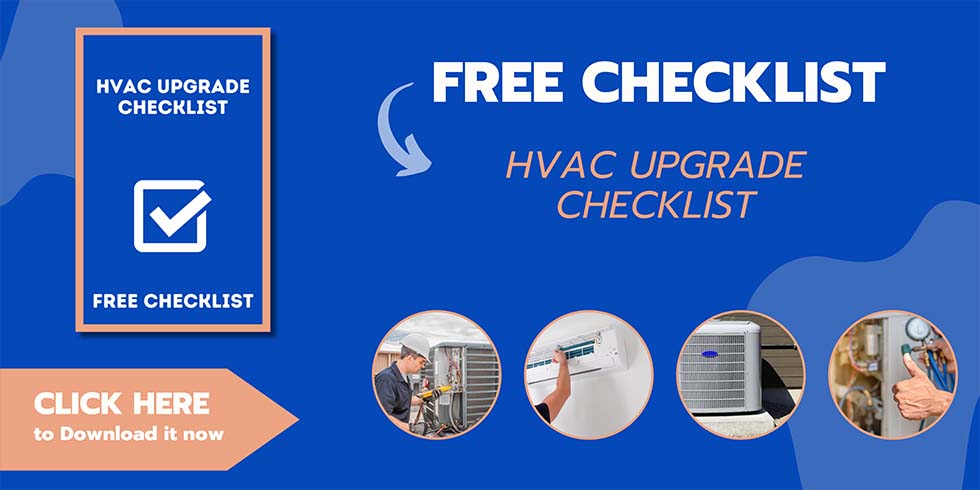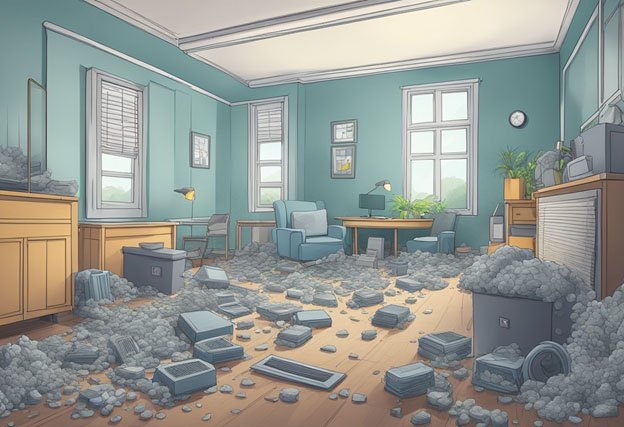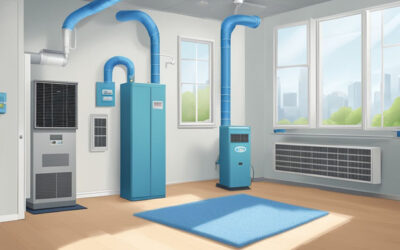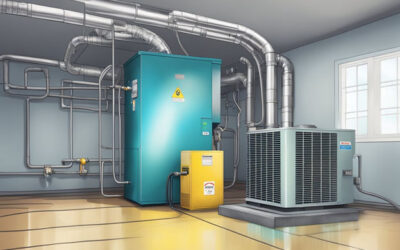Placing objects in front of air vents is a common practice in many households. People often place furniture, curtains, or decorations in front of their air vents without realizing the negative impact it can have on their HVAC system. In this article, we will explore the reasons why you shouldn’t place objects in front of your air vents and the potential consequences of doing so.
One of the main reasons why you shouldn’t place objects in front of your air vents is that it can reduce the efficiency of your HVAC system. When you obstruct the airflow from your air vents, your HVAC system has to work harder to circulate air throughout your home. This can result in higher energy bills and can even cause your system to break down over time.
Another reason why you shouldn’t place objects in front of your air vents is that it can affect the air quality in your home. When air can’t flow freely from your vents, it can create stagnant pockets of air that can become a breeding ground for mold and bacteria. This can cause health problems for you and your family, especially if anyone in your household suffers from allergies or respiratory issues.
Importance of Unobstructed Air Flow
Air vents play a crucial role in ensuring that your heating and cooling systems work efficiently. Placing objects in front of your air vents can obstruct the airflow, causing your HVAC system to work harder than necessary. This can lead to several problems, including increased energy consumption, decreased efficiency, and higher utility bills. Here are some reasons why you should avoid placing objects in front of your air vents.
Efficiency of Heating and Cooling Systems
When air vents are blocked, the air circulation in your home is restricted, and your HVAC system has to work harder to maintain the desired temperature. This can cause your heating and cooling systems to become less efficient, resulting in uneven temperatures throughout your home. Inefficient systems can also lead to increased wear and tear on your HVAC equipment, reducing its lifespan and increasing the likelihood of costly repairs.
Energy Consumption and Cost Savings
When your heating and cooling systems have to work harder to maintain the desired temperature, they consume more energy. This can lead to higher utility bills, especially during peak usage periods. By keeping your air vents unobstructed, you can ensure that your HVAC system is working efficiently, which can help reduce your energy consumption and save you money on your utility bills.
In conclusion, it is important to keep your air vents unobstructed to ensure that your heating and cooling systems work efficiently. This can help reduce your energy consumption, lower your utility bills, and extend the lifespan of your HVAC equipment. By taking simple steps to maintain unobstructed airflow in your home, you can enjoy a comfortable living environment while saving money and energy.
Potential Risks of Blocked Vents
Increased Fire Hazard
Placing objects in front of air vents can increase the risk of fire. When air cannot flow freely through the vents, the system can overheat and potentially cause a fire. This risk is particularly high if the blocked vent is located near a heat source, such as a stove or fireplace. It is important to keep all vents clear of obstructions to prevent this dangerous situation.
Mold and Mildew Growth
Blocked air vents can also lead to moisture buildup, which can result in mold and mildew growth. Mold and mildew thrive in moist environments and can cause serious health problems, such as respiratory issues, allergies, and skin irritation. By keeping air vents unobstructed, air can circulate properly, preventing moisture buildup and reducing the risk of mold and mildew growth.
Poor Air Quality and Health Concerns
When air vents are blocked, the air conditioning or heating system has to work harder to circulate air throughout the room. This can lead to poor air quality, as dust, dirt, and other particles are not properly filtered out. Poor air quality can cause a range of health problems, including headaches, fatigue, and respiratory issues. By keeping air vents clear of obstructions, air can circulate freely, improving air quality and promoting better health.
In conclusion, it is important to keep air vents unobstructed to prevent potential risks such as fire hazard, mold and mildew growth, and poor air quality. By taking simple steps to ensure that air can circulate freely, you can help keep your home safe and healthy.
Proper Ventilation Maintenance
Regular Cleaning and Inspection
Regular cleaning and inspection of air vents is crucial to maintain proper ventilation. Over time, dust and debris can accumulate in the vents, which can obstruct the airflow and reduce the efficiency of the HVAC system. It is recommended to clean the air vents at least once every three months to prevent any blockages.
To clean the air vents, turn off the HVAC system and remove the vent covers. Use a vacuum cleaner or a soft-bristled brush to remove any dust or debris that has accumulated inside the vent. It is important to avoid using harsh chemicals or water to clean the vents, as this can damage the system.
In addition to cleaning, it is important to inspect the air vents regularly for any signs of damage or wear. Check for any cracks or holes in the vent covers, as well as any signs of rust or corrosion. If any damage is found, it should be repaired or replaced immediately to prevent any further damage to the HVAC system.
Professional HVAC Servicing
Professional HVAC servicing is also important for proper ventilation maintenance. A professional HVAC technician can perform a thorough inspection of the entire system, including the air vents, and identify any potential issues before they become major problems.
During a professional HVAC servicing, the technician will clean the air vents and check for any signs of damage or wear. They will also inspect the entire HVAC system, including the air filters, ductwork, and thermostat, to ensure that everything is functioning properly.
Regular professional HVAC servicing can help to extend the lifespan of the HVAC system and improve its efficiency. It is recommended to schedule a professional servicing at least once a year to ensure that the system is working at its best.
Best Practices for Furniture Placement
Strategic Room Layout
When it comes to placing furniture in a room, it’s important to consider the location of your air vents. Placing furniture directly in front of air vents can obstruct airflow and reduce the efficiency of your heating and cooling system.
To avoid this issue, it’s best to strategically layout your room with the location of your air vents in mind. Place larger pieces of furniture, such as sofas and beds, away from air vents to ensure proper airflow.
Alternative Storage Solutions
If you’re struggling to find a place for your furniture that doesn’t block your air vents, consider alternative storage solutions. Wall-mounted shelves or cabinets can provide storage space without taking up floor space that could block air vents.
Another option is to choose furniture with built-in storage, such as ottomans or bed frames with drawers. These pieces can provide storage while still allowing for proper airflow throughout the room.
By following these best practices for furniture placement, you can ensure proper airflow and maximize the efficiency of your heating and cooling system.
Understanding HVAC Systems
Components and Operation
HVAC (Heating, Ventilation, and Air Conditioning) systems are designed to maintain comfortable temperatures and air quality in indoor spaces. These systems consist of several components that work together to achieve this goal.
The main components of an HVAC system include the thermostat, air handler, ductwork, and air vents. The thermostat is responsible for controlling the temperature in the room. When the temperature drops below the desired level, the thermostat signals the air handler to turn on. The air handler then pulls air from the room through the return ducts, filters it, and heats or cools it before sending it back out through the supply ducts and air vents.
The air vents are an essential part of the HVAC system. They are designed to distribute the heated or cooled air evenly throughout the room. When objects are placed in front of the air vents, the airflow is obstructed, and the system has to work harder to maintain the desired temperature. This can cause the system to wear out faster and result in higher energy bills.
Common Issues and Troubleshooting
One of the most common issues with HVAC systems is poor airflow. This can be caused by a variety of factors, including dirty air filters, blocked ducts, or a malfunctioning air handler. To troubleshoot this issue, it is essential to check the air filters regularly and replace them when they are dirty. It is also important to ensure that the air vents are not blocked by furniture or other objects.
Another common issue with HVAC systems is uneven heating or cooling. This can be caused by a variety of factors, including leaky ducts, improperly sized equipment, or a malfunctioning thermostat. To troubleshoot this issue, it is important to have the system inspected by a professional HVAC technician. They can identify the root cause of the problem and recommend the necessary repairs or replacements.
In summary, understanding the components and operation of your HVAC system is essential for maintaining optimal performance and energy efficiency. By avoiding placing objects in front of your air vents, you can ensure that your system operates smoothly and efficiently.





0 Comments